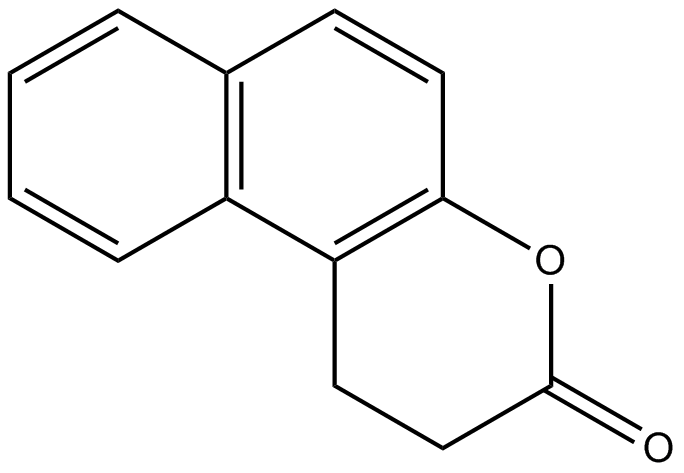Splitomicin |
| Catalog No.GC10555 |
Inhibitor of yeast Sir2p
Products are for research use only. Not for human use. We do not sell to patients.

Cas No.: 5690/3/9
Sample solution is provided at 25 µL, 10mM.
Splitomicin is a selective inhibitor of Sir2p with IC50 value of 60 μM and also a inhibitor of fMLP-induced free radicals with IC50 value of 40.79 ± 9.85 μM [1, 3].
Inhibition of the HDA of Sir2p was the most likely mechanism by which splitomicin caused its phenotypic changes. The direct target of splitomicin is Sir2p deacetylase activity. In addition, splitomicin specific inhibited fMLP-induced superoxide anion release.
In vitro, splitomicin inhibitd NAD+-dependent histone deacetylase activity of the Sir2 protein with an IC50 value of 60μM. By using a [3H]-acetylated histone H4 peptide and measuring the NAD+- dependent release of free [3H]acetate in the presence of whole yeast cell extract from an hst2 strain overexpressing yeast SIR2, a cell extract was obtained from a SIR2-overexpressing hst2 strain. The result established Sir2p deacetylase activity as a direct target of splitomicin. In addition, neutrophils induced by either fMLP (1 μM) or PMA (100 nM) were observed using a flow cytometer and the intracellular production of superoxide anions was investigated at different splitomicin concentrations. Splitomicin inhibited fMLP-induced Mac-1 expressionand increase cAMP levels in human neutrophils [1, 3].
Splitomicin's naphthoic moiety might be responsible for its inhibitory effects on platelets. By using washed human platelets, the inhibitory effects of splitomicin on platelet aggregation were studied and platelet aggregation and ATP release induced by thrombin (0.1 U/ml), collagen (2 μg/ml), arachidonic acid (0.5 mM), U46619 (2 μM) or ADP (10 μM) was monitored. Splitomicin inhibited platelet aggregation in a concentration dependent manner. Splitomicin increased cAMP and this effect was enhanced when splitomicin (150 μM) was combined with PGE1 (0.5 μM). The inhibitory mechanism of splitomicin on platelet aggregation may increase cyclic AMP levels via inhibition of cyclic AMP phosphodiesterase activity and subsequent inhibition of intracellular Ca ion mobilization, TXB2 formation and ATP release [2].
References:
[1]. Bedalov A, Gatbonton T, Irvine WP, et al. Identification of a small molecule inhibitor of Sir2p. Proceedings of the National Academy of Sciences of the United States of America, 2001, 98(26): 15113-15118.
[2]. Liu FC, Liao CH, Chang YW, et al. Splitomicin suppresses human platelet aggregation via inhibition of cyclic AMP phosphodiesterase and intracellular Ca++ release. Thrombosis Research, 2009, 124(2): 199-207.
[3]. Liu FC, Day YJ, Liou JT, et al. Splitomicin inhibits fMLP-induced superoxide anion production in human neutrophils by activate cAMP/PKA signaling inhibition of ERK pathway. European Journal of Pharmacology, 2012, 688: 68-75.
Average Rating: 5 (Based on Reviews and 30 reference(s) in Google Scholar.)
GLPBIO products are for RESEARCH USE ONLY. Please make sure your review or question is research based.
Required fields are marked with *




















